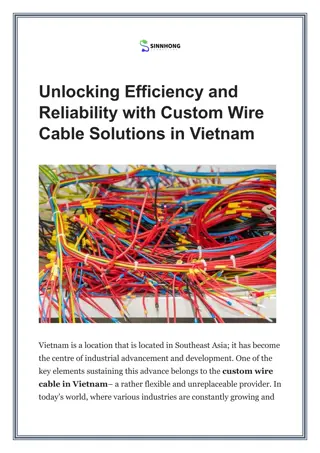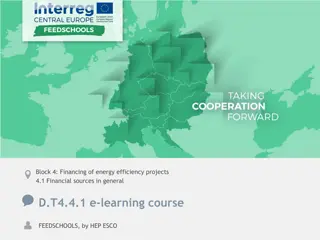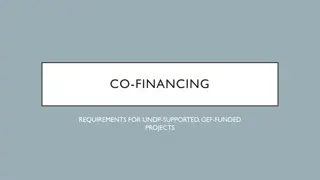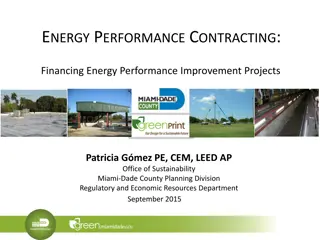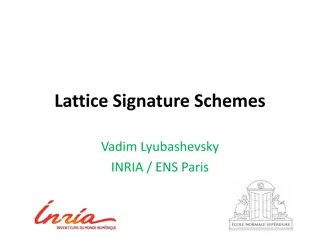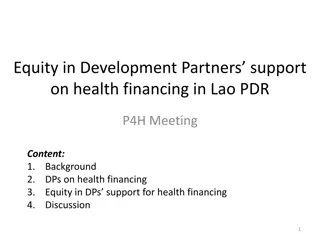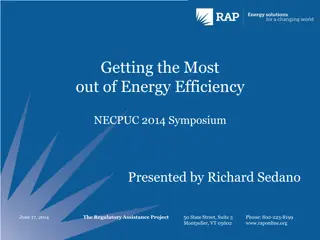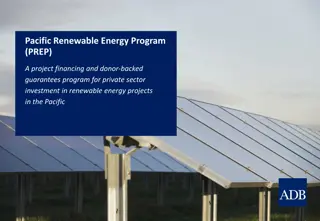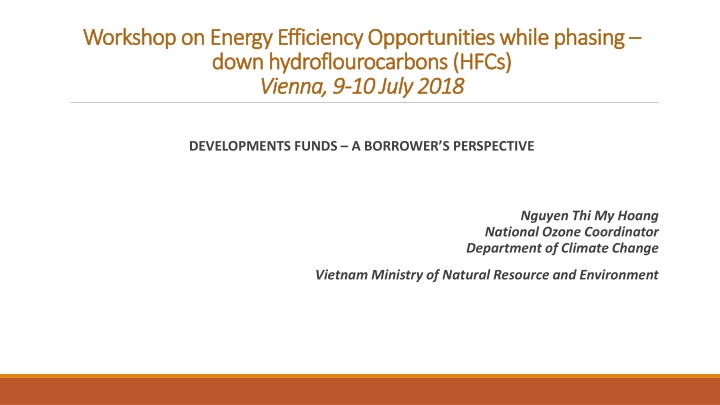
Financing Schemes for Energy Efficiency Projects in Vietnam
Vietnam offers various financial schemes to support new Energy Efficiency projects, such as soft loan options provided by funds like the Vietnam Environmental Protection Fund, National Technology Innovation Fund, and Green Credit Trust Fund. These funds aim to promote cleaner production technologies, reduce environmental impact, and drive sustainable development in Vietnam.
Download Presentation

Please find below an Image/Link to download the presentation.
The content on the website is provided AS IS for your information and personal use only. It may not be sold, licensed, or shared on other websites without obtaining consent from the author. If you encounter any issues during the download, it is possible that the publisher has removed the file from their server.
You are allowed to download the files provided on this website for personal or commercial use, subject to the condition that they are used lawfully. All files are the property of their respective owners.
The content on the website is provided AS IS for your information and personal use only. It may not be sold, licensed, or shared on other websites without obtaining consent from the author.
E N D
Presentation Transcript
Workshop on Energy Efficiency Opportunities while phasing Workshop on Energy Efficiency Opportunities while phasing down down hydroflourocarbons hydroflourocarbons(HFCs) Vienna, 9 Vienna, 9- -10 July 2018 10 July 2018 (HFCs) DEVELOPMENTS FUNDS A BORROWER S PERSPECTIVE Nguyen Thi My Hoang National Ozone Coordinator Department of Climate Change Vietnam Ministry of Natural Resource and Environment
BRIEF INTRODUCTION OF VIETNAMS FINANCING SCHEMES RELATED TO BRIEF INTRODUCTION OF VIETNAM S FINANCING SCHEMES RELATED TO ENERGY EFFICIENCY ENERGY EFFICIENCY In Vietnam, we have several funds which can be provided a soft loan scheme in preparations of new Energy Efficiency projects, such as: Vietnam Environmental Protection Fund: Vietnam Environment Protection Fund has function of receiving capital sources from the state budget; sponsor, contribution, commission from domestic and international organizations, individuals to support finance through a soft loan for environment protection activities/projects through the country. National Technology Innovation Fund: Providing preferential loans, subsidized loan interests and loan guarantees, and to grant expenses to carry out research, technology transfer and innovation. NATIF's charter capital is about 50 million USD from state budget for science and technology activities and is annually added for conservation. Green Credit Trust Fund (GCTF): The Swiss State Secretariat for Economic Affairs (SECO) supports through so-called Sustainable Enterprise Development centers (SEDs) sustainable industrial production modes in developing countries. Objectives: to promote long-term investments to SMEs in cleaner production technology with a positive impact on the environment and to contribute to the sustainable development of Vietnam This is achieved thanks to a reduction of the demand on collateral (50% guarantees) and a partial reimbursement (up to 25 %) of the invested capital, based on the environmental impact resulting from the investment Operational structure: GCTF operates with the participants of commercial banks: ACB, VIB, Techcombank; Vietnam Cleaner Production Centre (VNCPC); The Swiss State Secretariat for Economic Affairs (SECO)
An successful example for engaging between the GEF project and the An successful example for engaging between the GEF project and the Vietnam Environmental Protection Fund Vietnam Environmental Protection Fund In GEF cycle 5 we cooperated with UNIDO for implementation of the GEF5 project on Reducing greenhouse gas and ODS Emissions through technology transfer in industrial refrigeration . In the project we replacing HCFC-22 system with no ozone depleting, very low GWP hydrocarbon system: After the pilot and operation in four cold stores in Ho Chi Minh City, Hanoi, Nghe An and Quang Ninh, the HC-290 was used as a refrigerant with a 25% reduction in average power consumption compared to the HCFC-22 refrigerant. Replacement technologies in pilot businesses have eliminated approximately 250 kg of HCFC-22 used in the old cooling systems, reducing emissions by more than 450 tons of CO2 equivalent. Technology transfer has been successfully implemented in the four selected companies. Through the project we introduced about the soft loan which is provided by Vietnam Environmental Protection Fund (VEPF) for duplication of the pilot. And the companies are very interested in that soft loan and they made a plan for application this soft loan when they expand their factory.
Preparation Preparation of new Energy Efficiency projects in the planning where we want to engage of new Energy Efficiency projects in the planning where we want to engage much more with national and international investment/development banks because: much more with national and international investment/development banks because: Linking up with International Financing Institutions or national financing is a key driver for scaling up projects on phasing down HFCs Energy efficiency component brings in the business case to convince financial institutions and SMEs to invest and ensure therefore long term impact Best approach to target international and national financial institutions with dedicated funds for environmental impact - EE projects in area of montreal protocol/kigali amendment have double benefit because of direct and indirect emission savings
Key challenges to overcome for SMEs Key challenges to overcome for SMEs Lack of knowledge on specific financial instruments Difficulty in training large amount of SMEs in accessing those funds Predict exact savings and time line, always depends on specific case/technology/enterprise involved Extensive coordination and admin necessary Ideally combined approach, where beneficiaries are also trained/capacity is built on new EE technologies used to maximize EE reductions and therefore also monetary savings beside the environmental impact Limited number of national banks and funds availability Technical skills to asses specific sector of EE in refrigeration and AC are limited on site of financial institutions (FI), especially if national bank is involved - SMEs don t have resources to provide and explain to Financial institutions Credit ratings and risk evaluation are especially for SMEs not favourable SMEs need low interest rate, favourable repayment grace periods and installments payments Set up of harmonized evaluation criteria for FIs and SME to evaluate to prepare pipeline projects





